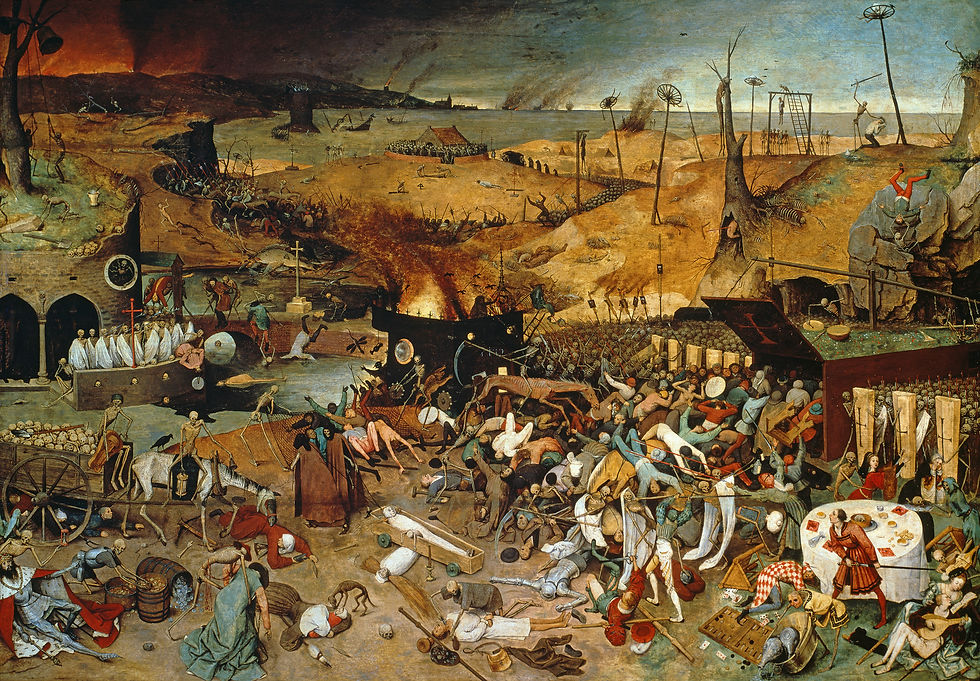*1525-1569
Europe
Brueghel the Elder
Pieter
21
Artist ID:
He was a formative influence on Dutch Golden Age painting and later painting in general in his innovative choices of subject matter, as one of the first generation of artists to grow up when religious subjects had ceased to be the natural subject matter of painting. He also painted no portraits, the other mainstay of Netherlandish art. After his training and travels to Italy, he returned in 1555 to settle in Antwerp, where he worked mainly as a prolific designer of prints for the leading publisher of the day. Only towards the end of the decade did he switch to make painting his main medium, and all his famous paintings come from the following period of little more than a decade before his early death, when he was probably in his early forties, and at the height of his powers.
Pieter Brueghel the Elder * c. 1525 probably in Breda; † 9 September 1569 in Brussels), called de Drol "the Droll" or "Peasant Brueghel", was a painter of the Dutch Renaissance. He is popularly known for his depictions of peasant life in the Duchy of Brabant (Netherlands and Flanders) in the 16th century. Pieter Brueghel the Elder was known for his landscapes and peasant scenes (so-called genre painting); he was a pioneer in making both types of subject the focus in large paintings.
Pieter Brueghel the Elder * c. 1525 probably in Breda; † 9 September 1569 in Brussels), called de Drol "the Droll" or "Peasant Brueghel", was a painter of the Dutch Renaissance. He is popularly known for his depictions of peasant life in the Duchy of Brabant (Netherlands and Flanders) in the 16th century. Pieter Brueghel the Elder was known for his landscapes and peasant scenes (so-called genre painting); he was a pioneer in making both types of subject the focus in large paintings.

World of Art
The Tower of Babel
37
Art ID
1563
|
114,0 x 155,0 cm
Oil on panel
225000000
$
Pieter
Brueghel the Elder

World of Art
The Triumph of Death
38
Art ID
1562
|
117,0 x 162,0 cm
Oil on panel
185000000
$
Pieter
Brueghel the Elder

World of Art
The Children‘s Games
39
Art ID
1560
|
118,0 x 161,0 cm
Oil on panel
185000000
$
Pieter
Brueghel the Elder

World of Art
The Peasant Wedding
40
Art ID
1568
|
114,0 x 164,0 cm
Oil on panel
205000000
$
Pieter
Brueghel the Elder
Further Works of This Artist

Our Mission and Actions
At THE ART HUB, our mission is initially focused on addressing a profound imbalance within the art world, specifically catering to women artists. In the current landscape, a mere 5% to 15% of artworks traded at auctions are created by women, starkly contrasted by the overwhelming 85% to 95% of works by male artists. This disparity is not only confined to auctions but is also prevalent in exhibitions, where male-created art significantly overshadows that of their female counterparts.
By concentrating our efforts on female artists, THE ART HUB aims to counteract this imbalance and champion women within the art community. This initiative is designed to amplify the visibility of women artists, making their creations more accessible to a wider audience, and ultimately striving for a more balanced representation of genders within art auctions and exhibitions. By prioritizing women in art, our platform boldly advocates for equality and diversity within the art sector, signaling a commitment to reshaping and enriching the cultural landscape.

As well as looking forwards, his art reinvigorates medieval subjects such as marginal drolleries of ordinary life in illuminated manuscripts, and the calendar scenes of agricultural labours set in landscape backgrounds, and puts these on a much larger scale than before, and in the expensive medium of oil painting. He does the same with the fantastic and anarchic world developed in Renaissance prints and book illustrations. He is sometimes referred to as "Peasant Brueghel", to distinguish him from the many later painters in his family, including his son Pieter Brueghel the Younger (1564–1638). From 1559, he dropped the 'h' from his name and signed his paintings as Brueghel; his relatives continued to use "Brueghel" or "Breughel".
He was a formative influence on Dutch Golden Age painting and later painting in general in his innovative choices of subject matter, as one of the first generation of artists to grow up when religious subjects had ceased to be the natural subject matter of painting. He also painted no portraits, the other mainstay of Netherlandish art. After his training and travels to Italy, he returned in 1555 to settle in Antwerp, where he worked mainly as a prolific designer of prints for the leading publisher of the day. Only towards the end of the decade did he switch to make painting his main medium, and all his famous paintings come from the following period of little more than a decade before his early death, when he was probably in his early forties, and at the height of his powers.






